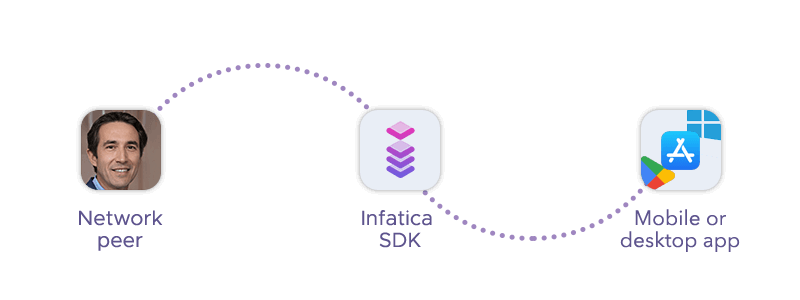Monetization Model for Apps
As the app economy enters its post-advertising era, the monetization model for apps must evolve beyond banners, interstitials, and reward units. In 2025, developers are pivoting toward hybrid strategies that combine subscriptions, in-app purchases (IAP), and passive SDK-based data models. This article builds on our June 13 post by detailing three new hybrid use cases, updating policy risk factors, and analyzing the technical and economic dimensions of SDK monetization—particularly through Infatica SDK.
With regulations such as Google’s updated Ads Transparency Policy (April 2025) and DMA enforcement in the EU, visibility into ad-related monetization has become not just a user-rights issue but a developer liability. Silent models that operate outside of the visible ad domain minimize both user friction and regulatory exposure.
Rethinking Monetization in a Post-Ad World
 Google Play’s policy update in 2025 requires developers to declare who pays for any in-app ad unit via the Ads Transparency Center. DMA further restricts opaque consent flows and mandates standardization across platforms. These changes erode the long-standing dominance of advertising-based monetization, especially for games and utilities on Android.
Google Play’s policy update in 2025 requires developers to declare who pays for any in-app ad unit via the Ads Transparency Center. DMA further restricts opaque consent flows and mandates standardization across platforms. These changes erode the long-standing dominance of advertising-based monetization, especially for games and utilities on Android.
In this environment, a monetization model for apps must satisfy four conditions: policy resilience, revenue scalability, UX neutrality, and data compliance. Hybrid models that combine transaction-driven revenue (subscriptions, IAP) with continuous passive monetization via SDKs meet these conditions more reliably than any one strategy alone.
Evaluating Hybrid Monetization Models: A Structured Approach
Developers planning to transition to hybrid models in 2025 should follow a structured seven-stage evaluation:
- User base assessment—DAU volumes, retention, and conversion.
- Model selection—subscriptions, IAP, SDK monetization, or hybrids.
- SDK integration—must be lightweight, compliant, multi-platform.
- Testing—performance validation to avoid drain or lag.
- Analytics setup—ARPDAU, eCPM, Sub-ID LTV, cohorting.
- ARPU optimization—testing hybrid monetization flows.
- Compliance scaling—alignment with Google Play 2025 rules.
The Compliance Reality: Google Play 2025 Checklist
Since April 2025, all monetization mechanisms—visible or background—must comply with Google Play’s updated rules. A robust SDK strategy should ensure:
- Non-ad models or declared payer info.
- Minimal permission requests and background access.
- Automated opt-out, consent, deletion support.
- Signed, verifiable updates.
- No negative performance or UX impact.
Silent SDKs like Infatica fall outside ad-related classifications and reduce enforcement risk.
How Infatica SDK Meets Modern Monetization Demands
Infatica SDK enables peer-to-business monetization with zero visible impact. It supports Android, Windows/macOS, and browser extensions, using encrypted and anonymized background tasks only after consent. SDK weight is under 1 MB, and performance impact is <1% CPU/RAM in tests.

It includes Sub-ID support for tracking LTV by source, rev-share or fixed-license models, and SDK-only revenue streams are tracked separately. GDPR and CCPA compliance is built-in and continuously updated.
Comparative Landscape: SDKs in 2025
| SDK Platform | Infatica SDK | Honeygain | Proxyrack |
|---|---|---|---|
| Model | Peer-to-business | Bandwidth resale | Proxy leasing |
| Binary Size | <1 MB | ~3–5 MB | ~4 MB |
| Sub-ID LTV | Yes | No | No |
| GDPR Compliance | Full | Basic | Manual |
| Performance | <1% overhead | 3–4% battery | Medium impact |
| User Reach | 100% | 30–40% | 50–60% |
Three New Hybrid Monetization Strategies for 2025
Three updated hybrid models show how SDK monetization can complement transactional flows:
1. Freemium subscription + SDK: While premium users pay, free users still monetize passively. In one deployment, SDK added €0.08 to ARPDAU.
2. IAP + SDK: Casual games monetize via items; SDK lifts non-payer monetization. eCPM equivalent exceeded €6 for non-converters.
3. Browser extension + SDK: Light tools can monetize background traffic while offering low-cost subscriptions.
Puzzle Game Case Study: Infatica SDK Deployment
A puzzle game with Android and browser versions (60,000 DAU) integrated Infatica SDK. Post-integration metrics showed ARPDAU growth from €0.14 to €0.20 and LTV from €3.00 to €4.25. 96% of users generated SDK revenue. SDK eCPM averaged €6.80 across cohorts. No UX complaints were reported.
This aligns with AppsFlyer’s 2025 Forecast, which suggests hybrid models will outperform ad-only approaches by year-end.
Addressing Developer Concerns
Battery: Infatica SDK uses <1% CPU; traffic is batched and delayed when idle.
Privacy: Consent-based, with anonymized session routing. Sub-ID for LTV tracking.
Performance: All SDK tasks are non-blocking, async, and background-prioritized.
Conclusion
In a post-ad monetization era, hybrid models that combine subscriptions, IAP, and passive SDKs offer more predictable, compliant, and platform-agnostic revenue. Infatica SDK is designed for this future: invisible to users, visible to dashboards, and ready for Windows/macOS/Android/browser environments.
For deeper insights:
To discuss integration, contact us or visit the Infatica SDK page.
